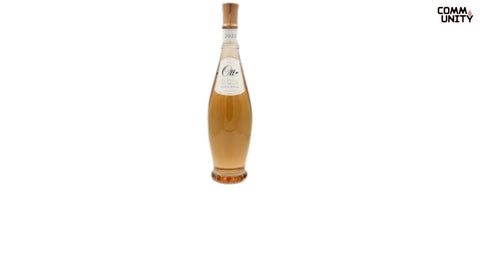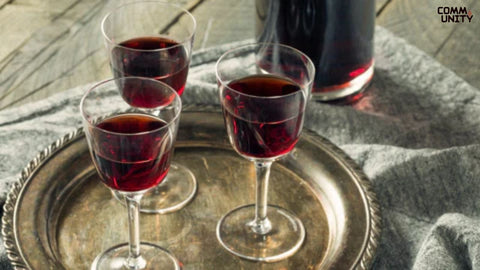While wine is a beloved alcoholic beverage all around the world, rosé wine is the variant that’s enjoyed for its color, freshness, and approachable taste.
One may often confuse the word rosé with rose. However, the first type is a kind of wine while the other one refers to a flower.
However, the answer to whether rosé wine is sweet isn’t simple. Rosé wine sweetness depends on how the wine is made, which grapes are used, and the winemaker’s style. So, let’s break down everything you need to know about rosé wine and its sweetness.
By Ott Cotes de Provence rosé 2024, Community Wine and Spirits
The Sweetness Spectrum in Rosé Wine
A simple rosé wine sweetness chart below gives a better understanding of rosé wines and their sweetness levels.
Rosé wine doesn’t fit into just one flavor profile. Like its counterparts (red wine and white wine), it ranges from bone-dry to very sweet. The sweetness depends on how much sugar remains after fermentation; the less the sugar content, the drier the wine is.
-
Dry rosé: Almost no sugar is left. It tastes crisp, light, and refreshing.
-
Off-dry rosé: A little sugar remains. It has a subtle sweet note on the tongue.
- Sweet rosé: Noticeably sweet, often with a fruity and juicy character.
What Makes Rosé Wine Sweet or Dry?
There are several factors that influence how sweet or dry a rosé wine turns out. These include grape variety, climate, and the fermentation process. Let’s look at each in more detail.
Grape Varieties Used
Different grapes naturally produce different flavors. Some give a dry taste, others give a more fruit-forward or sweet taste. Common grapes in rosé include:
-
Grenache: Bright red fruit, soft texture, often dry.
-
Syrah: Darker flavors, sometimes spicy, usually on the drier side.
-
Zinfandel: Juicy and bold, often used in sweeter rosé wines.
Grapes with more natural sugar typically increase rosé wine sweetness, such as, when the fermentation is stopped early.
Fermentation Process
The longer wine ferments, the more sugar is turned into alcohol. If winemakers stop fermentation early, more sugar remains. That makes the wine sweeter. Fully fermented wines are much drier and lighter than those that are stopped earlier in the process.
Climate and Growing Region
Wines from warm climates tend to be richer and sweeter. Cooler regions produce grapes with more acidity and less sugar. This means rosés from cool areas often taste drier and more tart.
How to Know If a Rosé Is Sweet
Understanding wine labels helps you know what to expect before tasting. Many producers include clues on sweetness.
Look for these words:
-
Dry, Brut, or Sec: These terms all denote the presence of little or no sugar in the rosé wine (includes anywhere between 0 to 32 grams of sugar)
-
Off-dry or Demi-Sec: Slightly sweet, soft and balanced (includes anywhere between 32 to 50 grams of sugar)
-
Sweet, Doux, or Dessert: Expect noticeable sweetness and lower alcohol content (includes more than 50 grams of sugar)
Note: Do also check the alcohol content. Wines under 11% alcohol are often on the sweeter side.
Tasting Differences: Dry vs. Sweet Rosé
rosé wine sweetness changes how rosé feels and tastes in your mouth. Here’s what to expect at each level.
Dry rosé
-
Crisp and clean on the finish.
-
Often tastes like red berries, citrus, or herbs.
-
High acidity with little to no sugar.
Off-Dry rosé
-
Slight fruitiness with a hint of sweetness.
-
Balanced acidity keeps it refreshing.
-
Sometimes there are notes of strawberry, watermelon, or cherry.
Sweet rosé
-
Smooth and rich with sugary notes.
-
Lower acidity, juicy finish.
-
Flavors may include raspberry jam, peaches, or candied fruit.
The difference lies in how long the sugar remains present and how acidity balances it.
Why People Think Rosé Is Always Sweet
There’s a common belief that all rosé wine is sweet, but that’s not always the case. The myth of the default rosé wine sweetness level comes from the popularity of certain sweet, mass-market rosé styles. However, high-quality rosé wine can be very dry and complex.
Rosé is not just a “beginner’s wine.” It offers just as much variety and depth as red or white wine types. In any case, the winemaking method and origin matter more in rosé's quality than the color or brand.
Styles of rosé and Their Sweetness Levels
Knowing where rosé comes from can hint at its sweetness.
Typically Dry Rosé Styles
-
Made in regions with old-world traditions.
-
Often include higher acidity and mineral flavors.
-
Crisp and food-friendly.
Typically Sweet Rosé Styles
-
Sometimes labeled as “blush” wine.
-
Popular in warmer regions or casual wine markets.
-
Juicy and easy-drinking.
Note: These are not strict rules but useful trends when choosing a bottle!
Pairing Food With Rosé Based on Sweetness
Sweetness affects how rosé wine pairs with food, as in the case of red and white ones. Here’s a simple guide:
Dry Rosé Food Pairings
-
Best with grilled vegetables, seafood, or herbed chicken.
-
Works well with salty snacks (such as hummus, charcuterie, etc.) or mild cheeses.
Off-Dry Rosé Food Pairings
-
Great with spicy food like Thai or Indian cuisines.
-
Also goes well with fruit-based salads or soft cheese
Sweet Rosé Food Pairings
-
Pairs well with desserts just as well as it does with spicy barbecue.
-
Complements dishes that have sweet sauces.
Choosing the right food pairing not only enhances the taste of wine, it also makes food taste better, making it a win-win!
How Temperature Changes Rosé's Sweetness Perception
Serving temperature can make a wine seem more or less sweet. Cold temperatures reduce the taste of sugar, while warmer ones highlight it.
-
Dry rosé: Serve around 50°F–55°F for balance and crispness.
-
Sweet rosé: Serve cooler, around 50°F–55°F, to keep it fresh and not taste artificially sweet.
Note: At the same time, avoid serving too cold as well, as this can mute the flavors and aromas of the wine.
Final Thoughts on Rosé Wine Sweetness
Rosé wine is not just one thing. It can be bone-dry or dessert-sweet. Understanding what influences its flavor helps you choose with confidence. From grape variety to fermentation, many factors decide how sweet a rosé will be.
The next time you ask, “Is rosé wine sweet?” remember that it all depends on the amount of sugar content and the serving temperature.
Buy the best rosé wines from Community Wine and Spirits, and get transported into the true world of wine from wherever you are.


